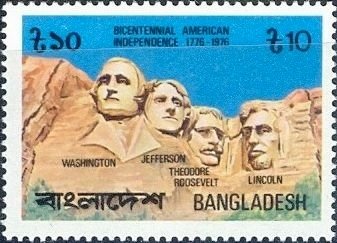Stamp: American Independence- Mt Rushmore, Presidents’ heads (Bangladesh 1976)
American Independence- Mt Rushmore, Presidents’ heads (Bangladesh 1976)
29 May (Bangladesh ) within release American Revolution goes into circulation Stamp American Independence- Mt Rushmore, Presidents’ heads face value 10 Bangladeshi taka
| Stamp American Independence- Mt Rushmore, Presidents’ heads in catalogues | |
|---|---|
| Michel: | Mi:BD 77 |
| Stanley Gibbons: | Sg:BD 83 |
| Stamp Number: | Sn:BD 114 |
| Yvert et Tellier: | Yt:BD 74 |
Stamp is square format.
Stamp American Independence- Mt Rushmore, Presidents’ heads it reflects the thematic directions:
A head of state (or chief of state) is the public persona that officially represents the national unity and legitimacy of a sovereign state. In some countries, the head of state is a ceremonial figurehead with limited or no executive power, while in others, the head of state is also the head of government. In countries with parliamentary governments, the head of state is typically a ceremonial figurehead that does not actually guide day-to-day government activities and may not be empowered to exercise any kind of secular political authority (e.g., Queen Elizabeth II as Head of the Commonwealth). In countries where the head of state is also the head of government, the president serves as both a public figurehead and the actual highest ranking political leader who oversees the executive branch (e.g., the President of the United States).
A monument is a type of structure that was explicitly created to commemorate a person or event, or which has become relevant to a social group as a part of their remembrance of historic times or cultural heritage, due to its artistic, historical, political, technical or architectural importance. Examples of monuments include statues, (war) memorials, historical buildings, archaeological sites, and cultural assets. If there is a public interest in its preservation, a monument can for example be listed as a UNESCO World Heritage Site. The Palgrave Encyclopedia of Cultural Heritage and Conflict gives the next definition of monument:


